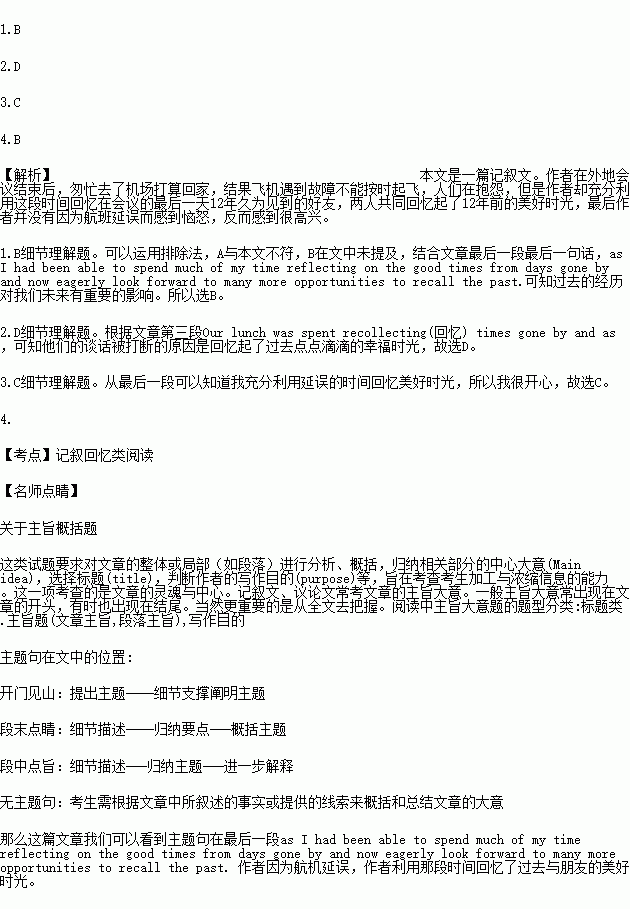题目内容
阅读理解
I had arrived at the airport to catch an early flight home.It had been a very busy three days for me on an interstate trip with lots of meetings,business to do and new customers to meet.Then came the announcement that the flight had been delayed due to a technical problem.I could see a group of technicians and ground staff rushing about,obviously trying hard to fix the problem.I watched and listened as many of the passengers sitting near me shared their frustration about the inconvenience.
As I sat waiting,I reflected on my last meeting for the day.It was not a business meeting but rather a very enjoyable and brief lunch with an old business associate and friend I had not seen for over 12 years,and who I had worked with for nearly 15 years before we lost in touch.I had been given his phone number by a customer I had visited on the first day of my trip,so I called him out of the blue and made a time for us to meet.
Our lunch was spent recollecting(回忆) times gone by and as well filling each other in on what had happened in our lives over the last 12 years.Our conversation was frequently interrupted with statements such as ‘remember when we did...’,‘whatever happened to...’ and of course the one we all liked to hear...‘you know you haven't changed one bit,except for a few more grey hairs.’
We both laughed and smiled as we recalled the good times and the great experiences we had shared over the 15 years we had worked together. Each event we discussed caused another recollection and everything we talked about centered on the good times.Almost at the same time,right at the end of our time together,we both said how much we both enjoyed it and that we must do it again.We agreed to catch up when I was next in town,then said our goodbyes and I was off to the airport.
So with this extra time on my hands as I waited for my flight,it was great to revisit and replay in my mind all that we had talked about over lunch.I realized at that moment just how important it is to have regular reminders of the good times in your life and to be able to take the time to recall the past,for so much of what we have done in our past,shapes us and makes us who and what we are today and beyond.
At the end of my busy trip with the focus on getting all the business done,I was indeed fortunate enough to have had the chance to take a short break and reflect on the good things that had happened in my life over 12 years ago.It was somewhat like looking at an old photo album that you have found stored away in a cupboard in your house.There before your eyes are lots of wonderful memories in print that take you back to that time and place,and most importantly to those people who are in the photos.It also made me realize that when you get caught up doing what has to be done in the moment,it is easy to forget the people you have met in your life who have made a positive effect on and enriched you,often in only the smallest of ways.
My flight home was finally called nearly three hours later and yes as you would have expected many of the passengers cheered when the announcement was made.I smiled as I boarded the plane and realized that I was not at all upset about the delay,as I had been able to spend much of my time reflecting on the good times from days gone by and now eagerly look forward to many more opportunities to recall the past.
1.Which of the following statements will the writer most probably support?
A.It is impossible to avoid the inconvenience caused by flight delays.
B.Our past experiences have a great influence on our future life.
C.Looking forward is more important than looking back on the past.
D.It is really a pity that the good old times will never come back.
2.The detail that their conversation was frequently interrupted is mentioned in order to show ________.
A.they were eager to make the conversation go smoothly
B.they had been very good and close friends
C.they were both interested in each other's present life
D.they had a good time recollecting their old times
3.When the writer boarded the plane,he smiled because ________.
A.he could finally fly home
B.the other passengers were cheering
C.he had made very good use of the delay
D.his busy trip would soon come to an end
4.Which of the following is the best title for the passage?
A.The Value of Old Friends
B.Reflecting on the Good Times
C.A Delayed Flight Home
D.A Three-day Business Trip

